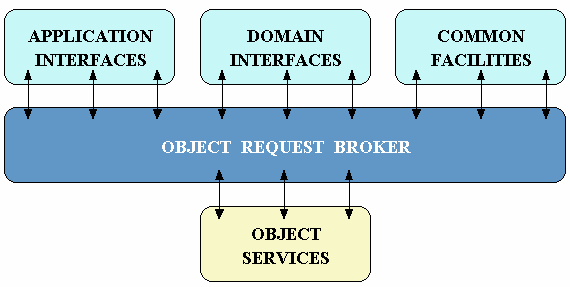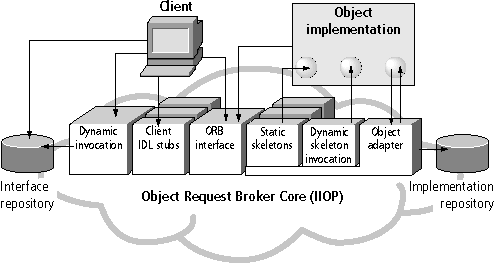





Published on Feb 14, 2025
Distributed objects are the next wave in Internet innovation. CORBA, the Common Object Request Broker Architecture defined by the Object Management Group (OMG), specifies how software objects distributed over a network can work together without regard to client and server operating systems and programming languages.
CORBA is a complete distributed object platform. It extends applications across networks, languages, component boundaries, and operating systems. A CORBA Object Request Broker (ORB) connects a client application with the objects it wishes to use.
The client application does not need to know whether the object resides on the same computer or on a remote computer elsewhere on the network. The client application needs to know only two pieces of information: the object's name and how to use the object's interface. The ORB takes care of the details of locating the object, routing the request, and returning the result.
CORBA grew at the same time as three influential trends, which lent credence to the CORBA vision. First, the software development community realized the importance of object-oriented programming techniques, even though they’d been around for the better part of two decades. Second, industry leaders - including IBM, Microsoft, and Apple - were advocating new application models based on small, task-specific components instead of large, general-purpose monoliths. The components would be easy to write and update, since they were small.
Developers could more conveniently, and cheaply, upgrade only those parts of their software that were out of date, and users wouldn't have to purchase entirely new versions of the entire package. And the small components could be distributed over a network more easily than their gargantuan ancestors. The more enlightened of these component architectures promised a cross-platform future, where all components could work together entirely independent of the underlying operating system.
The Common Object Request Broker Architecture (CORBA) is an emerging open distributed object computing infrastructure being standardized by the Object Management Group (OMG). CORBA automates many common network programming tasks such as object registration, location, and activation; request demultiplexing; framing and error-handling; parameter marshalling and demarshalling; and operation dispatching. The following figure illustrates the primary components in the OMG Reference Model architecture.

• Object Services -- These are domain-independent interfaces that are used by many distributed object programs. For example, a service providing for the discovery of other available services is almost always necessary regardless of the application domain. Two examples of Object Services that fulfill this role are:
o The Naming Service -- which allows clients to find objects based on names;
o The Trading Service -- which allows clients to find objects based on their properties.
• Common Facilities -- Like Object Service interfaces, these interfaces are also horizontally-oriented, but unlike Object Services they are oriented towards end-user applications. An example of such a facility is the Distributed Document Component Facility (DDCF), a compound document Common Facility based on OpenDoc. DDCF allows for the presentation and interchange of objects based on a document model, for example, facilitating the linking of a spreadsheet object into a report document.
• Domain Interfaces -- These interfaces fill roles similar to Object Services and Common Facilities but are oriented towards specific application domains. For example, one of the first OMG RFPs issued for Domain Interfaces is for Product Data Management (PDM) Enablers for the manufacturing domain. Other OMG RFPs will soon be issued in the telecommunications, medical, and financial domains.
• Application Interfaces - These are interfaces developed specifically for a given application. Because they are application-specific, and because the OMG does not develop applications (only specifications), these interfaces are not standardized. However, if over time it appears that certain broadly useful services emerge out of a particular application domain, they might become candidates for future OMG standardization.
A CORBA Object Request Broker (ORB) is the middleware that establishes the client-server relationship between objects. Using an ORB, a client object can invoke a method on a server object that can be on the same machine or across a network. The ORB intercepts the call and finds an object that can implement the request, pass it the parameters, invoke its method, and return the results. CORBA, like SQL, provides both static and dynamic interfaces to its services. The client does not have to know the object's location, its programming language, its operating system, or any other system aspects that are not part of an object's interface. Also, the client and server roles are dynamic: an object on the ORB can act as either client or server, depending on the occasion

Together, ORBs and the CORBA architecture provide the mechanism for CORBA objects to communicate. The objects are small software components that provide some kind of a service, such as access to a database, account management, or inventory tracking. Fundamental to the architecture are the ORBs. For any client or server to be a part of the CORBA scheme, it must include an ORB to help it find and communicate with other CORBA objects. Once outfitted with an ORB, a client or server can use the services of any CORBA object on any server or host on the network.
An object can be both a client and a server: when it provides services to another object, it's a server; when it requests services from another object, it's a client. The CORBA architecture provides a set of services that help objects interact with each other. (In the CORBA world, services means both the services provided by the CORBA architecture to help objects communicate and the functionality provided by the objects themselves.)
CORBA also defines a special language - IDL -which provides a language-neutral way of describing a specification for a CORBA object and the service(s) it provides. IDL lets components written in different languages communicate with each other using IIOP and the rest of the CORBA architecture. (Objects with IDL-defined interfaces are said to be CORBA-compliant.).
Currently, it’s easiest to provide an IDL specification for objects written in C, C++, and Java, because the OMG has completed mapping schemes - or translation guides - from IDL to those languages. Also, there are already compilers that employ those mapping schemes to translate IDL to C, C++, and Java. (OMG is currently working on IDL mappings for ADA, SmallTalk, and other languages.)
CORBA objects may sit on different types of systems - Windows or Unix servers, IBM 3090 or DEC VAX mainframes. They may even be written in different languages. In fact, the objects don't need any inherent knowledge of each others' existence. As long as the interface to the service provided by the object is written in IDL, all the objects can communicate and use each others' services through ORBs sitting on clients, servers, database systems, mainframes, and other systems on the network.
| Are you interested in this topic.Then mail to us immediately to get the full report.
email :- contactv2@gmail.com |